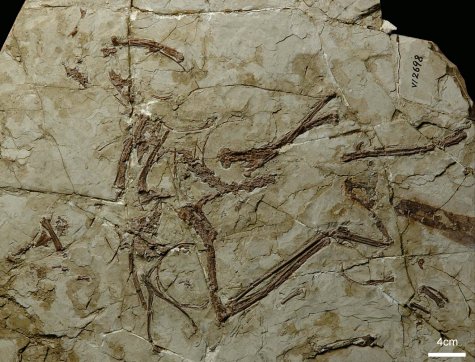|
|
|
||||||||||||||||||||||||||||||||||||||||||||||||
|
简介(Brief Introduction) |
|
[A]会鸟是早白垩世最大的鸟类。通过三种鸟类翅膀的比较,会鸟、始祖鸟、和孔子鸟,做一个翅膀长短的比较,我们可以看到,这个鸟类比始祖鸟的个体还要大很多,但是比孔子鸟还要大得更多,这实际上就说明到早白垩世这个时期,鸟类不光在形态,生活习性,系统发育方面出现很大分化,在它个体的大小方面也出现了很大的差异。那么这一件比较完整的会鸟标本,我们可以看到,它的翅膀上还保存了爪的构造,另外它的尾巴,但是已经十分缩短,这一点特征已经和其他进步的鸟类非常相似。
最新发表的一种被称为会鸟的鸟类,却是热河生物群已知最大的鸟类,它甚至比始祖鸟还要大。会鸟不仅个头大,而且还具有不少十分原始的特征。据估计是一类滑翔飞行的高手。2001年11月16日首次发表在德国的杂志<Naturwissenschaften>,其发现地点位于:
[B]<Anatomy of the primitive bird Sapeornis chaoyangensis from the Early Cretaceous of Liaoning, China> Zhonghe Zhou and Fucheng Zhang Can. J. Earth Sci./Rev. Can. Sci. Terre 40(5): 731-747 (2003) Abstract: Two new, nearly completely articulated skeletons of Sapeornis chaoyangensis provide much new information about the anatomy of this basal avian, particularly in the skull, pectoral girdle, forelimb, and hind limb. This new material shows that the hand of Sapeornis, with a phalangeal formula of "2–3–2," was more derived than previously reconstructed. The skeleton of Sapeornis has several unique features, such as a distinctively elongated fenestra on the proximal end of the humerus, a robust furcula with a distinctive hypocleidum, and an elongated forelimb. Sapeornis exhibits a combination of derived and primitive features, including a short, robust non-strut-like coracoid and a fibula reaching the distal end of the tarsal joint (as in Archaeopteryx), a pygostyle, reduced manual digits, and a well-fused carpometacarpus (as in more advanced birds). These features further indicate the mosaic pattern in the early evolution of birds and confirm the basal position of Sapeornis near Archaeopteryx and Jeholornic in the phylogeny of early birds. The preservation of gastroliths in one of the new specimens also represents the first Chinese Mesozoic bird with such evidence, indicating a herbivorous feeding habit and providing further evidence for our understanding of the diet diversification in early avian evolution. |
|
化石写真(Fossil Pic.) |
|
IVPP V 12698 |
|
复原图(Restitute Pic.) |
|
|
|
|
|
本站复原图(保留版权)(Copyrighted Restitute Pic.) |
|
|

